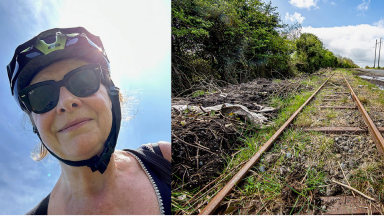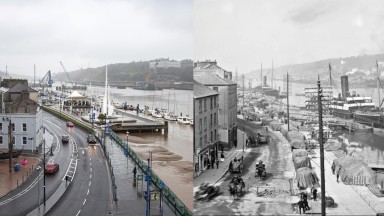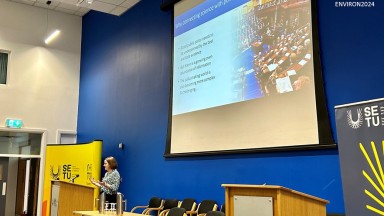The honour of being selected as the inaugural National Library of Ireland (NLI) and Environmental Protection Agency (EPA) Photographer-In-Residence is overwhelming, in a good way. I have called the project ‘ReViewing Ireland’, and intend to travel the twenty-six counties that come under the purview of both bodies, taking photographs pertinent to many different aspects of environmental issues of the day. This will be undertaken using science-based guidance from the EPA and relevant historic information about environmental issues from the NLI, alongside my own artist-led eye. The aim is to create a snapshot in time of Ireland’s environment over the course of one year, four seasons, with 120 of the resulting photographs curated, and captioned, to become part of the National Photographic Archive.

"The joys of cycling: just before getting lost in the bog"
In a nutshell, the plan for ReViewing Ireland is to visit each county – primarily using public transport, e-bike, local taxi or all three – taking mostly contemporary photographs, but some ‘Then and Now’ photos from the exact same spot as old photographs from in the National Photographic Archive (NPA). It is hard to photograph some environmental issues, so using archive images is a way to capture the changes wrought over time.
A good example of ‘Then and Now’ – past and present images working together – resulted from a trip to Waterford. The archive online threw up a photograph of Reginald’s Tower on the Waterford city quays, taken some time between 1865 and 1914. The newer photograph, taken last March from Room 404 of The Tower Hotel, shows essential flood defences by way of opaque fencing – it has to be said, an elegant urban planning design in response to flooding. We all know only too well the increase in flooding and erosion on our coastline.

Reginald’s Tower on the Waterford city quays March 2024, photograph: Paula T Nolan & Reginald's Tower 1880-1900, photograph: Robert French (L_ROY_02089)
A time of writing, I am aged sixty-four. I want to include this personal detail to encourage others who are thinking of starting something new later in life. At fifty years of age, I decided to take up photography. I bought what is called an ‘entry level’ camera, enrolled in a year-long course and the rest is history.
I now cannot imagine life without a camera around my neck. It’s how I express love of life, disgust with life, fears and hurts, losses and grief, a spirit of fun, interest in you and in everything; it’s how I breathe my thoughts and emotions into the world. It’s a way of seeing and being that feels as much a part of me as any limb.
My father used to say when I was a teenager, 'you’ll find your niche' – at the time his big ambition for me was to be a sales assistant in Arnotts, but only if I didn’t become a nun. Even then I couldn’t have imagined my niche would remain elusive until fifty years of age.
We live at a time when almost everybody is taking photographs. We are inundated with images to the point where our brains naturally curate which ones we engage with, and which ones we blank out. We have emojis to express the emotions elicited by the images we see, so that in five minutes of scrolling we might go the gamut: happy, sad, anxious, laughing, angry. But the one thing in my experience that most people engage with positively is natural beauty. Most people will Like, Love or Comment glowingly on photos that portray a sunset, a moon rise; images that highlight the wonders of the world. When did you last see a comment under a sunset, 'How dare you post a sunset…'
The spirit of wonder is a constant companion when I take up the camera, and I invite it to accompany me on this project as well, but it is no replacement for facts, trusted science and evidence. They work together. In order to properly cover the ambition of this project, and the aims of the NLI and EPA, my initial expectation was that the biggest learning curve would be on environmental issues. I wasn’t entirely wrong. Yet where my thinking was wrong is that I thought I’d spend a year with depressing statistics and bad news. Seven weeks into the project at time of writing, I can vouch this is not at all the case.

My first engagement with the EPA was being invited to attend a conference in Waterford in March: ENVIRON2024. This is where environmental scientists to go share their research, and invite individuals and companies with innovative sustainability strategies to make presentations. Over the course of several days I spoke with dozens of attendees, from PhD students, to researchers with many years under their belt, to company directors, and found a whole new world of people whose entire careers are built upon inventing ways to greatly increase the chances of saving planet earth. Over the months since then, I have met numerous staff at the EPA, and find all of them likewise to be positively engaged in the work they do, and both patient and generous in passing along some of their knowledge to Crocodile Dundee – that being me.
Engaging with the NLI is likewise a pleasure, meeting people with the exact same commitment to excellence and interest in their work as the EPA people I have met. My career as a graphic designer, and particularly in designing books, has meant I am already familiar with the National Library archives. I hope very much over the course of this project to lead more people to this unbelievably rich resource. So please, if you decide to keep an eye on the progress of this project over the year, let yourself dive into the National Library website, as one titbit, one photo, leads to another, and another, and another. Links as to how to engage with the project are below.
Being selected as the NLI/EPA Photographer-In-Residence is the greatest achievement of my life as an artist photographer. There is no subject closer to my heart, more important to us all, than the survival of mankind and nature in light of the threat posed by the climate crisis.
I am grateful for an opportunity to work visually with the subject, with people who know more than I do, to create a body of work that captures a year of Ireland’s environment.
A question I have asked myself for years before being selected for this project is that, given most people respond so well to the aforementioned wonders of the world – sunsets, solar eclipses, full moons, the aurora borealis – why do we destroy it?
Before he died in 1980 at age 79, philosopher-psychologist Erich Fromm was interviewed for television and asked how he felt about dying. At the time, he knew he did not have long to live. He answered that he was glad to be leaving the world, because he had finally decided, after a lifetime of study, that humans do not learn from past mistakes and he feared for the planet. At age 19 I saw this interview and it entered deep into my psyche. Sometimes you just ‘know in your knower’ that what you have heard is the truth. Or maybe you just know you can trust the harbinger.
What has this got to do with the NLI and the EPA collaborating on a Photographer-In-Residence initiative? Well, just about everything. The rich resource the NLI offers about all things to do with our past, combined with the evidenced-based work of the EPA to protect our present and future, seems the perfect formula to re-view – to look at again – the environmental status of Ireland; to frame the past and present in one project, and provide a year-long yardstick for future reference. To do what Erich Fromm feared we did not do: use the past as a teacher, and create a resource to act as a teacher to future interests. At all times ReViewing Ireland will take into account how the photographs and captions will be of interest and of use in 30, 50 and 100 plus years’ time.
As the Environmental Protection Agency celebrates 30 years this year, the collaboration with the National Library of Ireland on this Photographer-In-Residence initiative is inspired, and for this grateful photographer, a challenge and an honour beyond my wildest dreams.
The 2024 Photographer in Residence initiative of The National Library of Ireland (NLI) and the Environmental Protection Agency (EPA), aims to visually capture and record our experience of the Irish environment. The project is an artist’s exploration of the themes, and is not intended to represent the views of either organisation.
For the duration of the project, frequent updates are available on the NLI and EPA social media and the NLI website. You can follow the project in real time on the photographers own social media channels. All are listed below.
PAULA T NOLAN SOCIAL MEDIA
You can follow the project in real time on the photographers own social media channels listed below.

